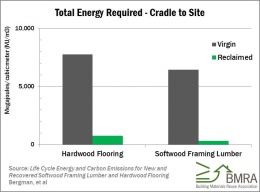
Carbon sequestration is the process of capture and long-term storage of atmospheric carbon dioxide (CO2). It occurs in nature as photosynthesis. Long-term storage of carbon dioxide or other forms of carbon can either mitigate or defer global warming and avoid dangerous climate change. It has been proposed as a way to slow the atmospheric and marine accumulation of greenhouse gases, which are released by burning fossil fuels.
Forests filter our air and water, and provide wildlife habitat. Today, the average tree produces enough oxygen for two people while sequestering 12-15% of annual U.S. nationwide carbon emissions. Forests in America currently store more than 40 billion tons of carbon. An additional 200 million tons of carbon (735 million tons of carbon dioxide) are sequestered each year – because of net forest growth – which is the equivalent of taking 135 million cars, or one-half of all vehicles, off the road. The additional carbon stored each year in forest products offsets roughly 1% of annual U.S. greenhouse gas emissions or 17% of annual U.S. building construction emissions.
Wood products lower a building’s carbon footprint in two ways. They continue to store carbon absorbed by the tree while growing and keep it out of the atmosphere for the lifetime of the building – longer if the wood is reclaimed and reused or manufactured into other products. And, when used in place of fossil-fuel intensive materials such as steel and concrete, the use of wood also results in ‘avoided’ greenhouse gas emissions.
Metric Tons of Carbon Equivalent (MTCO2)
You have no items in your list.
Click or tap on the My List stars on any business card or profile to add or remove organizations.